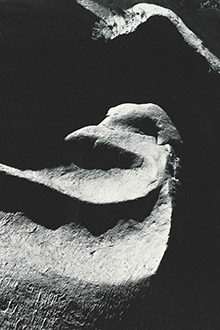
Minor White (American, 1908-1976). Sculptured Birds, Cape Meares Oregon. 1964. Gelatin silver print. Lent by Lindsay W. Marshall. The Minor White Archive, Princeton University Art Museum, bequest of Minor White © Trustees of Princeton University.
The work of photographer Minor White will be on view at Emory’s Michael C. Carlos Museum from Saturday, Oct. 12, until Sunday, Dec. 15. A special Collecting Conversation focused on the exhibit will take place Wednesday, Oct. 23, at 7:30 p.m.
“Minor White, Unburdened: Photography from the Collection of Lindsay W. Marshall” features White’s photography of the natural world alongside a selection of his writings and photography of his contemporaries and friends such as Ansel Adams, Edward Weston and Rose Mandel.
The exhibition pulls from the personal collection of Lindsay Marshall, a member of the museum’s Advisory Board and docent emerita, who became involved with the Carlos Museum after moving to Atlanta in 2000 when her husband, Fray Marshall, became chair of Emory’s urology department.
According to Paul Martineau, a curator of a 2014 exhibition on White at the J. Paul Getty Museum, White turned to photography because he understood that it would pull him out of himself and into the world, thus balancing his tendency toward introspection with engagement. So balanced, White could pursue self-discovery through the viewfinder.
In 1940, White took a job teaching photography at La Grande Art Center, but this was interrupted by World War II. At the conflict’s end, White thought that his experience of war may have deadened his creative impulse. However, helping Ansel Adams establish the first fine art photography program in the U.S. at the California School of Fine Arts brought White into contact with the great photographers of his generation and revived him.
White produced images of people and the natural world, with each subject area providing the breadth for him to explore human nature in all its facets. Intellectual and spiritual, White used photography to grapple with his inner life, including his homosexuality.
“I liked abstraction, and Minor White was the epitome of the genre,” Marshall says of her attraction to his work. “White pushed abstraction to its limits while maintaining a sense of reality in his photography.”
For example, an image of the surf beating against the shore speaks not only to the cyclic drama of the tides but also the vastness of the universe and man’s relative insignificance. “[White] created a message that transcends but defines his art,” Marshall says.
As a photography collector, Marshall focuses on modern minimalism and nature abstraction. She has never wavered in her commitment to White’s work, although his pivotal role in mid-century abstract modernism is underrecognized as is the generations of students he influenced.
“To me, an individual should like what art they embrace regardless of its presumed value,” she says.
